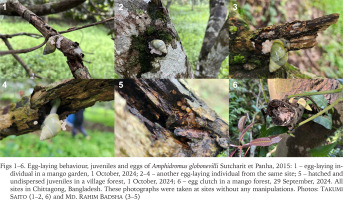The genus Amphidromus Albers, 1850, exhibits high phenotypic diversity, particularly in shell colour and chirality, which has attracted malacologists’ attention for many years (e.g., Fulton 1896, Laidlaw & Solem 1961). Over 400 morphological species have been described (MolluscaBase 2021), and the taxonomy has recently been revised based on genetic and anatomical data (Sutcharit & Panha 2006, Sutcharit et al. 2015, Inkhavilay et al. 2017, Jirapatrasilp et al. 2024). Furthermore, the phenotypic diversity, including chirality dimorphism, offers insights into evolutionary and ecological studies (e.g., Schilthuizen et al. 2007, Lee et al. 2022). Its habitat dependency on tropical forests has raised conservation concerns (Klorvuttimontara et al. 2017).
Despite the broader research focus, ecological information on Amphidromus remains limited (Laidlaw & Solem 1961). Most species are usually found on trees (Laidlaw & Solem 1961), and they are considered predominantly arboreal species (e.g., Sutcharit & Panha 2006). However, it is unclear whether their entire life cycle occurs arboreally. Evidence of arboreal egg-laying exists for some species: Amphidromus atricallosus atricallosus (A. Gould, 1843) and A. leucoxanthus (E. von Martens, 1864) from Thailand (Sutcharit & Panha 2006), and Amphidromus palaceus purus (Mousson, 1849) from West Java (Paravicini 1921) construct “nests” with leaves for egg-laying on trees. On the other hand, A. inversus annamiticus (Crosse et P. Fischer, 1863) from Thailand (Sutcharit et al. 2013) and A. inversus albulus Sutcharit et Panha, 2006 from Malaysia (Schilthuizen & Looijestijn 2009) lay eggs directly in tree hollows.
Here, we report novel observations of egg-laying behaviour in A. globonevilli Sutcharit et Panha, 2015 from eastern Bangladesh. This species, originally described from Thailand, is distributed across India, Myanmar, and Bangladesh in addition to Thailand (Sutcharit et al. 2015, Saito et al. 2024). However, ecological information – including egg-laying behaviour – was previously lacking for this species.
The egg-laying behaviour, eggs, and hatched juveniles of A. globonevilli were observed during field surveys in Chittagong, Bangladesh (29 September and 1 October 2024), in a mango (Mangifera indica L.) garden (22°54'22"N, 92°01'49"E). The morphologically identified A. globonevilli deposited pinkish-white egg capsules (more than 10–50 per clutch based on visible egg capsules) in small hollows of mango trees (Figs 1–4). Interestingly, a few egg capsules were attached to the shell (Figs 1 & 4) and some of the clutches were exposed outside from the hollows (Figs 1–3). In a village forest (22°58'50"N, 92°00'59"E), sinistral Amphidromus hatched juveniles were found in a hollow of a mango tree (Fig. 5). Juveniles of Amphidromus do not have enough diagnostic features in general (Laidlaw & Solem 1961) and are difficult to identify; nevertheless, we assumed that these juveniles are A. globonevilli, because A. globonevilli is the only Amphidromus species recorded in most localities in Bangladesh (Saito et al. 2024) and we also only observed A. globonevilli in this site. We also found similar eggs on a small hollow in a mango tree (Fig. 6). This site (22°11'17"N, 92°09'37"E) is a mango forest, where numerous A. globonevilli individuals were observed. Accordingly, these eggs are assumed to be A. globonevilli.
Figs 1–6
Egg-laying behaviour, juveniles and eggs of Amphidromus globonevilli Sutcharit et Panha, 2015: 1 – egg-laying individual in a mango garden, 1 October, 2024; 2–4 – another egg-laying individual from the same site; 5 – hatched and undispersed juveniles in a village forest, 1 October, 2024; 6 – egg clutch in a mango forest, 29 September, 2024. All sites in Chittagong, Bangladesh. These photographs were taken at sites without any manipulations. Photos: Takumi Saito (1–2, 6) and Md. Rahim Badsha (3–5)

These findings suggest that A. globonevilli completes its life cycle arboreally, utilizing tree hollows rather than leaves as “nests”. Although eggs were exclusively observed in mango trees during our surveys, A. globonevilli is found on other trees, such as the jackfruit tree (Artocarpus heterophyllus Lam.). Accordingly, A. globonevilli might use hollows of other tree species, but it has not yet been observed.
Although we conducted field surveys for land snails in other seasons in Bangladesh, we could not find any further examples of egg-laying behaviour of A. globonevilli. The egg-laying of A. globonevilli we observed occurred in late September to early October, and this seasonality aligns with reports for other Amphidromus species (Paravicini 1921, Sutcharit & Panha 2006, Sutcharit et al. 2013). However, regional climatic differences complicate interpretations: September–October marks the end of the rainy season in Chantaburi, Thailand, and Chittagong, Bangladesh, but the start of the rainy season in West Java (Japan Meteorological Agency 2025).

